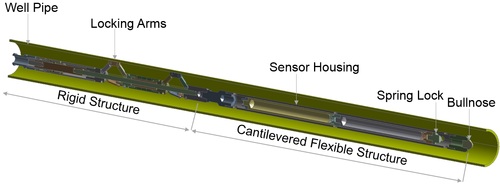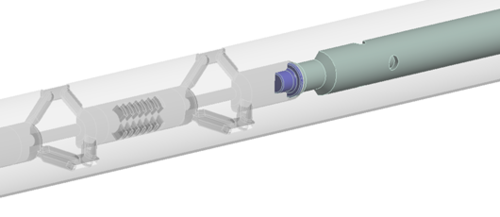The transient structural response due to fluid loading on a down-hole gauge hanger, including the frequency and magnitude of fluid-induced vibrations, was investigated by undertaking a fluid-structure interaction (FSI) analysis. The results showed that any initial vibrations decayed quickly and performance was acceptable across a range of flow conditions.
Company
Headquartered in Aberdeen, Omega Completion Technology is an innovative, independent well completion and intervention technology developer and manufacturer. With over 25 patents, the company focuses on robust, reliable down-hole tools.
Background
The High Expansion Gauge Hanger (HEGH) system is used for hanging off gauges and other tools in the well. The design consists of two bi-directional slip modules which self-centralise the tool in the well-hole. When in position, the modules extend radially outwards until they grip onto the side-walls, thereby preventing any movement of the HEGH.
Challenge
While the profile of the HEGH provides little resistance to the flow, Omega Completion had concerns that flow induced vibrations could result in the sensor housing and the well-hole side walls coming into contact. During normal operations, the fluid can pass over the system vertically in both directions. Consequently, vortex shedding and induced vibrations had to be considered for both operational cases.
To capture the fluid borne vibrations of the sensor housing, several physical phenomena were taken into account when developing the model:
a) Rattle and associated damping within the sensor housing and associated equipment
b) Possible contact between housing walls and the pipe bore
c) Fluid induced resonance
d) Associated structural response in parallel

To overcome these challenges, initial tests were undertaken on the sensor housing in isolation. The movement between the sensor and the internal equipment was found to be negligible under varying load conditions.
Consequently, the components could be treated as a single ‘bonded’ entity. Furthermore, using the contact tool in ANSYS, the model was setup such that surfaces could come in and out of contact without convergence issues. In addition, a small timestep was used that captured the natural resonance of the system and any higher frequencies also.
Lastly, given the stabilizing nature of the radial arms on the hanger, it could be assumed that the attached Sensor Housing is ‘cantilevered’ from the HEGH connector.

Solution
Using ANSYS’ Workbench interface, it was straightforward to couple the FEA and CFD solvers within a single GUI to create the 2-way FSI analysis. This integrated system enables any change to the multiphysics model to propagate through the entire simulation automatically.

Before analysing the effect of the flow, the sensor housing was given an initial disturbance to ensure that the bullnose was deflected away from the bore centre. This conservative approach demonstrated the ability of the system to return to its equilibrium position, even under perturbed initial conditions.

The results obtained in Figure 4 showed that while there was fluid borne vibration within the system, the frequency of this vibration was away from the natural modes of the system. Furthermore, any displacements due to fluid loading or initial conditions decayed quickly. This indicated that the possibility of the sensor housing walls coming into contact with the oil-well pipe was minimal.
Lastly, the simulation showed that for an organised vortex structure, the fluctuating Von-Mises stress and hydrodynamic forces obtained on the wetted surfaces were unlikely to cause gross movement (or slippage) of the radial arms for a given range of friction factors.
Business Benefit
Taking advantage of ANSYS’ coupling capabilities, alongside its ability to model dynamic non-linear contact and deforming mesh within the same simulation, Omega Completion were able to confirm efficiently that the design is suitable for downhole operations. The project involved running the same simulation set-up over several different flow conditions and two different geometries.
Making use of parallel computation and parametric updates, the entire project was turned around in less than a week. The equivalent experimental tests would have taken much longer to arrange and complete, while also incurring greater costs and development time.
